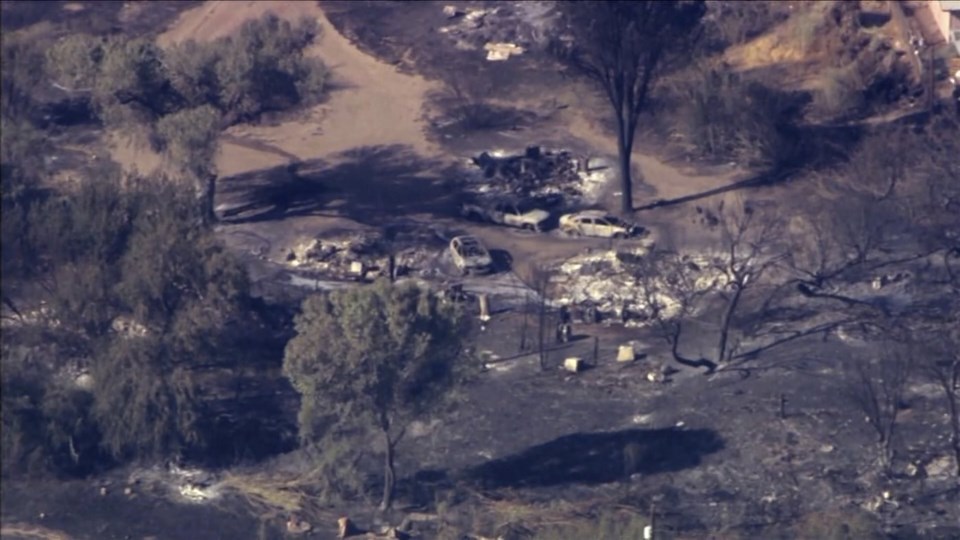SAN FRANCISCO (AP) — Wildfires fueled by strong winds and an extended heat wave have led to the first death in California of the 2024 season, while wind-whipped flames in Arizona have forced hundreds to flee from what tribal leaders are calling the “most serious” wildfire on their reservation in decades.
The fires were unfolding as authorities in Western states warned of the rising risk of wildfires amid this month's that has dried out the landscape, set temperature records and put lives at risk. In eastern California and Nevada, the parched conditions also prompted officials to increase staffing in order to better monitor “deteriorating conditions forecasted for this weekend,” the Humboldt–Toiyabe National Forest .
California's first death of the fire season was reported after Mendocino County officials said they found human remains in a home that had burned in a fire that started Monday. The coroner’s office is working to identify the body, but it may be that of a 66-year-old woman whose family reported her missing.
There have been other wildfires deaths in the West this season, including three people who were killed in New Mexico’s .
In Arizona, more than 400 residents on the San Carlos Apache Reservation were told to leave after a wildfire spilled into the downtown area on Thursday and destroyed at least 13 homes, officials said.
No injuries or deaths have been reported. But the tribe's chairman, Terry Rambler, called it the “most serious structural fire” on the reservation in decades.
Officials said arson was suspected in the fire, which had so far burned about 2 square miles (5.2 square kilometers) and remained at 0% containment as tribal leaders declared a state of emergency on the reservation.
“We have never experienced anything like this,” Rambler said Friday in a statement.
Patrick J. Victor began recording as the fire exploded around his home Thursday afternoon. His videos showed a dark sky over his neighborhood, wind whipping and carrying black smoke across the sky as his neighbor's property went up in flames.
“It looks like the fire pits of hell,” he said while walking through thick brush.
Victor, 39, said Friday that he kept praying for rain as walls of fire shot up and over the thick line of trees in his neighborhood. But the rain never came.
Although his family's home was untouched, Victor said he was devastated for his community.
“Some of these houses are second- and third-generation homes," he told The Associated Press.
Meanwhile, California’s top fire official said this week that so far this year, the state has responded to more than 3,500 wildfires that have scorched nearly 325 square miles (842 square kilometers) — five times the average burned through July 10 in each of the past five years.
“We are not just in a fire season, but we are in a fire year,” Joe Tyler, director of the California Department of Forestry and Fire Protection, said. “Our winds and the recent heat wave have exacerbated the issue, consuming thousands of acres. So we need to be extra cautious.”
California crews working in scorching temperatures and single-digit humidity were battling numerous wildfires, including a stubborn 53-square-mile (137-square-kilometer) blaze that prompted evacuation orders for about 200 homes in the mountains of Santa Barbara County northwest of Los Angeles.
California’s fires began in earnest in early June, following back-to-back wet winters that but spawned abundant grasses that have since dried out. A June blitz of lightning ignited some of the fires, a risk that may return with thunderstorms in the Sierra Nevada this weekend, forecasters said.
The deadly Mina Fire in Mendocino County, about 180 miles (290 kilometers) north of San Francisco, started Monday afternoon, likely from a burn pile on a property that had escaped and spread. The deceased 66-year-old woman was last seen on the property trying to protect her home with a garden hose, county officials said.
The fire had burned about 0.15 square miles (0.4 square kilometers) as of Friday and was 70% contained.
Officials across the West — including in Oregon, Nevada and Washington state — have imposed burn bans and other restrictions to avoid sparks. Campfires, operating chainsaws and target shooting are prohibited in most areas.
Fire crews in Oregon continued Thursday to fight the Larch Creek Fire, which grew to at least 16.6 square miles (43 square kilometers) of grassy areas since Tuesday. Lower temperatures and calming winds were helping their efforts, but the local fire danger level remained extreme. One firefighter was treated for heat-related injuries.
In Hawaii, Haleakala National Park on Maui was closed as firefighters battled a blaze on the slopes of the mountain. Visitors in more than 150 vehicles that had gone up Wednesday for the famous sunset views were not able to descend until around 4 a.m. Thursday because the narrow roads were blocked by fire crews.
More than people around the U.S. remained under heat alerts Friday — a significant reduction from earlier in the week. But forecasters said that some relief from the heat was due by the weekend.
The U.S. heat wave came as the global temperature in June was a record warm and marked the 12th straight month that the world was 1.5 degrees Celsius (2.7 degrees Fahrenheit) warmer than pre-industrial times, the European climate service Copernicus said. Most of this heat, trapped by human-caused climate change, is from long-term warming from greenhouse gases emitted by the burning of coal, oil and natural gas, scientists say.
___
Yamat reported from Las Vegas. Associated Press journalists Christopher Weber and John Antczak in Los Angeles; Jennifer Kelleher in Honolulu; Tran Nguyen in Sacramento, California; Martha Bellisle in Seattle; and Bruce Shipkowski in Toms River, New Jersey, contributed to this report.
Rio Yamat And Janie Har, The Associated Press




